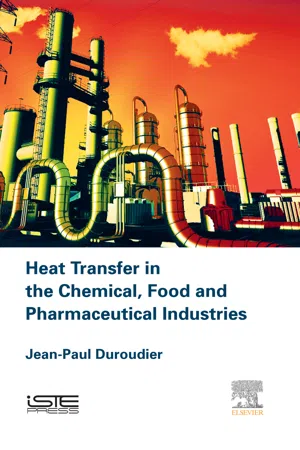
This is a test
- 414 pages
- English
- ePUB (mobile friendly)
- Available on iOS & Android
eBook - ePub
Heat Transfer in the Chemical, Food and Pharmaceutical Industries
Book details
Book preview
Table of contents
Citations
About This Book
Heat Transfer in the Chemical, Food and Pharmaceutical Industries, a new volume in the Industrial Equipment for Chemical Engineering set, includes thirteen independent volumes on how to perform the selection and calculation of equipment involved in the thirteen basic operations of process engineering, offering readers reliable and simple, easy to follow methods.
Throughout these concise and easy-to-use books, the author uses his vast practical experience and precise knowledge of global research to present an in-depth study of a variety of aspects within the field of chemical engineering.
- In this volume, the author focuses the heat exchanges between gases, liquids, divided solids and compact solids without changes of phase.
- This book includes discussion on changes of phase, heat exchange processes, combustion and the necessary equipment to measure these.
- The chapters are complemented with appendices which provide additional information as well as any associated references.
Frequently asked questions
At the moment all of our mobile-responsive ePub books are available to download via the app. Most of our PDFs are also available to download and we're working on making the final remaining ones downloadable now. Learn more here.
Both plans give you full access to the library and all of Perlego’s features. The only differences are the price and subscription period: With the annual plan you’ll save around 30% compared to 12 months on the monthly plan.
We are an online textbook subscription service, where you can get access to an entire online library for less than the price of a single book per month. With over 1 million books across 1000+ topics, we’ve got you covered! Learn more here.
Look out for the read-aloud symbol on your next book to see if you can listen to it. The read-aloud tool reads text aloud for you, highlighting the text as it is being read. You can pause it, speed it up and slow it down. Learn more here.
Yes, you can access Heat Transfer in the Chemical, Food and Pharmaceutical Industries by Jean-Paul Duroudier in PDF and/or ePUB format, as well as other popular books in Physical Sciences & Thermodynamics. We have over one million books available in our catalogue for you to explore.
Information
Topic
Physical SciencesSubtopic
Thermodynamics1
Rotary Calcination Kiln: Heat Exchange by Radiation
Abstract
Calcination is the thermal dehydration of a metal hydroxide or of a salt. Cement kilns are not, technically speaking, calcination kilns, but the same technique is used.
Keywords
Fill ratio; Gas heating; Grain breaking; Heat transfer; Kirchoff’s law for surfaces; Lining; Radiation; Radiosity; Rotary Calcination Kiln; Transfer mechanism
1.1 General points
1.1.1 Purpose of calcination kilns
Calcination is the thermal dehydration of a metal hydroxide or of a salt. Cement kilns are not, technically speaking, calcination kilns, but the same technique is used.
1.1.2 Specific characteristics of heat transfer
In this case, heat is not transferred by convection, but rather by radiation; the wall of the kiln, which is heated using gas, transfers this heat to the product at points where direct contact occurs due to the rotation of the kiln. This regeneration effect may represent between 30% and 40% of the ov...
Table of contents
- Cover image
- Title page
- Table of Contents
- Dedication
- Copyright
- Preface
- 1: Rotary Calcination Kiln: Heat Exchange by Radiation
- 2: Tubular Heat Exchangers and Flat-plate Heat Exchangers
- 3: Finned Tube Exchangers
- 4: Scraped Surface Heat Exchangers, Spherulation Towers and Solidification on a Moving Surface
- 5: Efficiency of Single-phase Heat Exchangers: Fouling
- 6: Condensers, Traps and Condensate Lines
- 7: Boiling and Heat Transfer
- 8: Thermosiphon Reboilers
- 9: Concentrating Solutions by Vaporization
- 10: Falling Film Vaporizer (Evaporator)
- 11: Heat Transfer in Stirred Tanks
- 12: Cooling or Heating of Simple-form Solids and Plant Products: Blanching
- 13: Thermal Insulation of Piping: Tracing
- 14: Combustion and Sulfur Dew Point
- 15: Heat Supply by Microwave or Infrared Radiation
- 16: Freezing, Deep-freezing and Thawing
- 17: Freeze-drying
- Appendix 1: Characteristics of Exchanger Tubes
- Appendix 2: Resistance, Conductance, Diffusance
- Bibliography
- Index